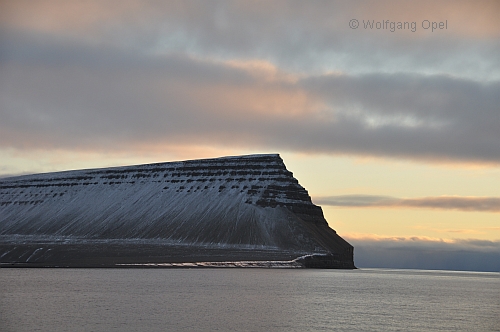Deutsche Version: Zuflucht in Whaler’s Point
reblogged from November 12th, 2012
When looking for „Whaler’s Point“, search engines find – among others – „Luxury Condominium with Spectacular Panoramic Ocean Views on the Cliffs“. There are indeed spectacular views of the ocean and cliffs in Port Leopold – but real estate agents have no business here.
This bay in the North-East of Somerset Iceland is located at the junction of four Arctic waterways – Lancaster Sound, Barrow’s Strait, Wellington Channel, and Prince Regent’s Inlet – and surrounded by table mountains. In front of the steep walls you see talus, which is already covered with powdered sugar snow in fall.

On shore, there are coastal terraces which consist mainly of slate-like pebbles: sharp and brittle, a seemingly colorless mass that shows its nuances only on closer inspection: Clay-colored? Greyish blue? Yellowish? Reddish? Brownish? A little bit of them all, in between also lichens in grey and deep orange-red, and now in the autumn here and there the grey-green of the few grasses, already discolored brownish leaves, and seed pods of Mountain Avens and Saxifrage. In the hollows, you can still see the snow of last night, blown in by the wind. A barren, inhospitable, remote place that looks not very attractive.

And yet there were residents in this place temporarily.
The first lived here already about a thousand years ago. On the coastal terraces, the stone foundations of dwellings which fall into the Thule culture can be found. These ancestors of today’s Inuit hunted seals, walruses, and especially whales, whose numerous bones are still scattered here around the archaeological sites. The number of ruins gives indication that it must have been a good place with an abundance of food.
A decaying wooden house at the end of the bay gives evidence of other temporary visitors – this time in the 20th century. The Hudson’s Bay Company had built a trading post here in 1926, which was in operation only for a few years.

In the 19th century, the Bay was named Whaler Point. Hundreds of whaling ships from Europe and New England came to the Arctic during the summer season and thousands of whales have been killed annually – a lucrative but also dangerous „trade“.
The sufficiently deep waters of the sheltered bay offered a retreat for the whalers – and even a mailbox in which they could leave messages. This mailbox consisted of an iron boiler, formerly part of the steam engine.
The first steamship that ever sailed to the Arctic was Victory of the expedition of 1829-33 under the command of Sir John Ross. Because of the – at this time still rudimentary – technology, the steam engine broke again and again and proved not useful anymore; so Ross finally ordered to dismantle it.
The boiler at Port Leopold probably comes from the steam launch of a further expedition:

In September 1848, Her Majesty’s ships Enterprize and Investigator, under the command of James Clark Ross, entered the harbour of Port Leopold for the purpose of establishing a depot of provisions that should be available, if necessary, to any other expeditions in search of the missing Franklin’s expedition. However, no sooner were the ships anchored than a heavy pack of ice was driven into the bay and completely closed the harbor’s mouth, effectually preventing their departure. For the next nine months they were locked in ice, so they were compelled to spend the winter there. When they were able to depart the next summer, they left behind a house, a steam launch and provisional foods like pemmican, chocolate and biscuits – designated for the use of Franklin’s or other expeditions.

Early in 1853, about 900 km further West in Mercy Bay of Banks Island, Captain McClure considered this depot as a possibility for the rescue – this was when the men of the frozen HMS Investigator, after three winters in the ice, were threatened by starvation. Johann August Miertsching, interpreter for Inuktitut on board of the Investigator, wrote in his diary on March 3rd:
„… officers…, with 26 sailors…, were appointed to go to Port Leopold… where in 1848 a house had been built with food, clothing, and coal in abundance, and where a small steamboat would also been found; from Port Leopold, they would endeavour to be picked up by a whaling ship in Baffin Bay and so be brought to England „. But Miertsching himself should take another route, together with seven companions, and scratch along approximately 1000 km in Southwest direction to Fort Good Hope.
Fortunately, this march of despair was no longer necessary, because on the day of departure on April 25, 1853, a rescue squad led by Lieutenant Bedford Pim emerged unexpectedly in Mercy Bay.
reblogged from November 2012 by Mechtild Opel – Deutsche Version: Zuflucht in Whaler’s Point

